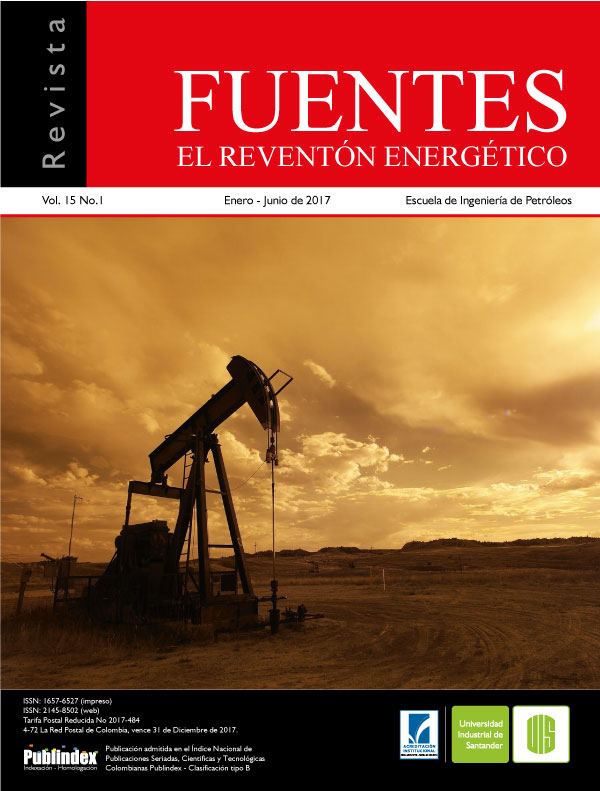Experimental methodology for two and three phase relative permeability estimation through history match
Published 2017-06-01
How to Cite
Abstract
This paper presents the development of a new methodology for relative permeabilities estimation, through the match of the simulation results with the experimental data, obtained from unsteady state displacements. The development of the simulationoptimization tool, in Matlab environment, necessary for the automatic match is presented too. Six unsteady state displacements are performed; four of two-phase and two of three-phase, the experimental data obtained are analyzed using the proposed algorithm. The results from two-phase experiments are compared with those of Sendra software and it is found that the proposed algorithm has a good performance respect to this commercial tool. The results from the three-phase cases show that the algorithm achieves effectively estimate the relative permeability that produce the history match; It is found that there are differences with respect to the estimated curves for two-phase systems.
Keywords: Relative Permeability Three-Phase, Coreflooding Simulation, Numerical Optimization, History Match.
Downloads
References
- Akhlaghinia, M., Torabi, F. y Chan, C. (2014). Experimental investigation of temperature effect on three-phase relative permeability isoperms in heavy oil system. Fuel, vol. 118, pp. 281-290.
- Aziz, K. y Settari, A. (1979). Petroleum Reservoir Simulation, Michigan: Applied Science Publishers.
- Brooks, R. y Corey, A. (1964). Hydraulic properties of porous media. Hydrological Papers, vol. 3.
- Chapra, S. y Canale, R. (2002). Numerical Methods for Engineers with Software and Programming Aplications. Fourth ed., McGraw-Hill.
- Chavent, G., Jaffré, J. y Jan, S. (1998). Estimation of relative permeabilities in three-phase flow in porous media. Inverse Problems, vol. 15, nº 1.
- Corey, A. (1954). The Interrelation Between Gas and Oil Relative Permeabilities. Prod. Monthly, vol. 19, nº 1, pp. 38-41, 1954.
- Ertekin, T., Abou-Kassem, J. y King, G. (2001). Simulation, Basic Applied Reservoir, Ridchardson, Texas: Society of Petroleum Engineers.
- Fassihi, M. (1989). Estimation of relative permeability from low rate, unsteady-state tests - a simulation approach. Journal of Canadian Petroleum Technology, vol. 28, nº 3, pp. 29-39.
- Grattoni, C. y Bidner, M. (1990). History Matching of Unsteady-State Corefloods for Determining Capillary Pressure and Relative Permeabilities. SPE Latin American Petroleum Engineering Conference held In Rio de Janeiro.
- Helset, H., Norvdtvedt, J., Skjæveland, S. y Virnovsky, G. (1998). Relative Permeabilities From Displacement Experiments With Full Displacement Experiments With Full,» SPE Reservoir Evaluation & Engineering, pp. 92-98.
- Killough, J. (1976). Reservoir Simulation with History-dependent Saturation Functions. Trans. AIME, vol. 261, pp. 37-48.
- Kreig, P. y Watson, A. (1986). Relative-Permeability Estimation From Displacment Experiments: An Error Analysis. SPE Reservoir Engineering, vol. 1, nº 2, pp. 175-182.
- Nordtvedt, J., Ebelfort, J., Iversen, A., Urkedal, H. y Vatne, K.(1997). Determination of Three-Phase Relative Permeabilities From Displacment Experiments. SPE, pp. 221-226.
- Oak, M. (1990). Three-phase Relative Permeability of Water-wet Berea. SPE/DOE Seventh Symposium on Enhanced Oil Recovery held in Tulsa, pp. 110-128.
- Pérez, E. (2008). Diseño de una metodología experimental para la evaluación de permeabilidades relativas en tres fase. Universidad Industrial de Santander, Tesis de Maestría (En Ingeniería de Hidrocarburos), Bucaramanga.
- Pérez, E., Santos, N. y Zapata, J. (2008). Diseño de una metodologia experimental para evaluación de permeabilidades relativas tres fases, Bucaramanga: UIS.
- Tarek, A. (2001). Reservoir Engineering Handbook, Second ed., Houston, Texas: Gulf Professional Publishing.
- Stone, H. (1970). Probability Model for Estimating Three-Phase Relative Permeability. Journal of Petroleum Technology, vol. 249, pp. 214-218.
